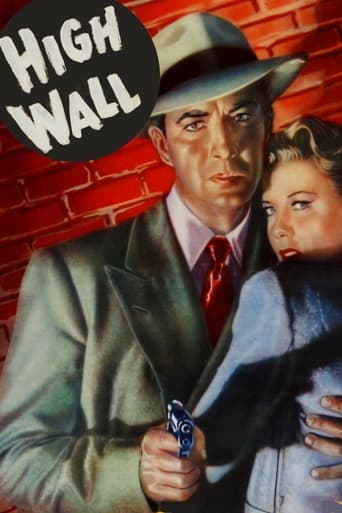

Something different for Robert Taylor. He stars as a possible insane killer who tries to prove his innocence.The film also showcases the acting talent of Audrey Totter. For a change, she is in a major role and not relegated to the many supporting roles she did in films.Much of the action takes place in an asylum where Taylor is committed after allegedly strangling his wife.Marshall Thompson is wonderful as the sinister boss who is the killer.The black and white photography depict the trouble that Taylor is in as he tries to prove his innocence. At first, Taylor did not want any help thinking that he was guilty. He thought that he could use his brain disorder on his behalf. When his mother suddenly dies, he needs to raise his 6 year old son.Totter is the compassionate psychologist who takes the child in and gradually comes to realize that Taylor is an innocent victim.This is a very interesting psychological thriller.
... View MoreThis is probably Robert Taylor's first real film noir. He is revered in some circles for work a decade later such as Nicholas Ray's "Party Girl." I think he is excellent in "High Wall." He plays a decorated war vet who is accused of murder. Not just accused of murder but also but into a psychiatric hospital. Yikes. No fun at all. Except that the hypnotherapist assigned to his case is a beautiful woman who kind of likes him.Cast in the role of the psychiatrist is one of the great staples of film noir, Audrey Totter. She is as always good. Better than good. What's intriguing here is that she is cast not as a femme fatale but as a career woman who is in every sense on the right side of the angels and the law.Herbert Marshall turns in a superbly creepy performance also. I won't say much about his role other than that this is not really a whodunit. We know the answer to that very early.It's an unusual, brave movie. It has flaws but is nevertheless very good.
... View MoreRobert Taylor is Steven Kenet, accused of killing his unfaithful wife in "High Wall," a 1947 film noir also starring Audrey Totter and Herbert Marshall. In our first glimpse of Steve, he's in a car with a dead woman careening down the road to get rid of her. The problem is, due to a brain injury suffered during the war, he can't remember what happened. He is institutionalized for psychiatric evaluation to see if he can stand trial as a sane person. Audrey Totter is Ann, the psychiatrist who takes in Steve's small son as well as works with her patient to try and uncover the truth. Herbert Marshall plays his dead wife's boss.After World War II, Hollywood began to explore mental and emotional disorders and the use of psychiatry to unlock the traumas of the mind. "Possessed," "Spellbound," and "The Snake Pit" are just a few of the dozens of films employing the use of psychiatry, mental hospitals, and/or psychotropic drugs. In "High Wall," the psychiatry seems to be more of a plot device than something that is actually used to help the patient. It's there to provide flashbacks. Meanwhile, the Taylor character, once he has surgery, has a mind of his own and is constantly slipping out or in the psychiatrist's office window, hiding in her car, and visiting the scene of the crime. The biggest problem is that the character of the murder victim is never developed, and the reasons for her behavior are never made clear. Nevertheless, the film manages to hold one's interest, has a great atmosphere and a couple of really shocking moments. There are also some very funny bits throughout, including a scene where Steve meets the public defender.This is one of Robert Taylor's best performances. After "Johnny Eager," one of Hollywood's biggest heartthrobs began to play more complex roles and more bad guys. It was a good move; he played them very well. He doesn't get much support from Audrey Totter, who turns in a dull, somewhat cold performance in an attempt to be a professional woman. She doesn't give the role a lot of shading. Herbert Marshall seems somewhat miscast and is too lethargic for a role that requires some emotional range.Very watchable for handsome Taylor's excellent performance.
... View MoreI'm only commenting on this movie because of it's high ratings(7.6). The whole psychiatric story is unbelievable. Brain surgery does not have a certain outcome and in this case certainly wasn't indicated. Truth serum did not exist in 1947 and isn't invented yet. And if it existed why would really anyone bother to do serious investigations. Just let us make an appointment with all suspects and apply the serum. The motivations of the real murder don't seem sufficient. The plot often jumps from one scene to the next without the expected connection. After the janitor blackmails the murder we know it's over with him. I haven't seen any other movie with Robert Taylor so it may be that this is his best performance. By today's standards this is not more than4 / 10.
... View More